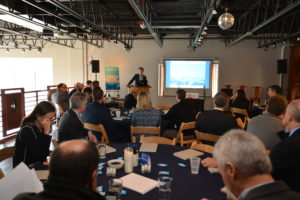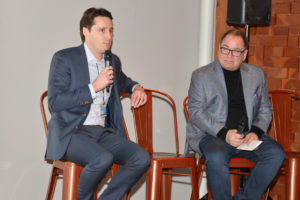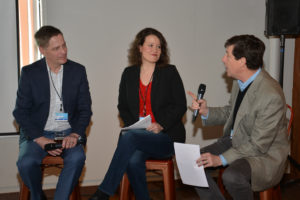 Innovation isn’t just the purview of behemoth tech companies and scrappy startups. Rather, strides in innovation can be found in organizations of all sizes and industries, and in places we’d least expect. That was the message of the distinguished panel of speakers at the March 22 Innovatus Summit, which explored the concept of “Achievable Innovation.”
Innovation isn’t just the purview of behemoth tech companies and scrappy startups. Rather, strides in innovation can be found in organizations of all sizes and industries, and in places we’d least expect. That was the message of the distinguished panel of speakers at the March 22 Innovatus Summit, which explored the concept of “Achievable Innovation.”
Sponsored by Kohrman Jackson & Krantz, Cohen & Company and Skyscraper, Inc., the Innovatus Summit drew more than 50 business leaders and innovators for a keynote address, panel discussion and hands-on activity to fuel innovative thinking. Here are just a few of the key insights from the event’s accomplished lineup of presenters.
Behind the scenes at “the world’s largest organization no one’s ever heard of”: The Innovatus Summit welcomed Lou Von Thaer, CEO of Battelle, as keynote speaker. Founded in 1923, Battelle is the world’s largest independent not-for-profit R&D organization, but Von Thaer acknowledged that its innovative work has largely occurred behind the scenes. That’s included Battelle’s work in creating xerography and the first Xerox copier in 1959, to innovation in compact discs in 1974, to today’s technologies to detect biological pathogens. Other innovations Battelle works on today include systems that deliver real-time information to first responders during active shooter situations, unmanned aerial technology that disrupts enemy drones and medical devices that use deep brain stimulation to return movement to individuals with paralysis.
 Innovation where you’d least expect it: “You wouldn’t think of a law firm as being a place where you’d typically find innovation,” said KJK Partner Jon Groza in his remarks to Innovatus attendees. Yet he said law firms and other professional services organizations are environments that are ripe for innovation. As an example, Groza gave an overview of a new technology platform in the works at KJK to change the way businesses access legal services called Connective Counsel. In his joint presentation with Don Greenberg, CEO and Managing Partner of Skyscraper, Inc., Groza also discussed trends in professional services in favor of partnerships rather than siloed services.
Innovation where you’d least expect it: “You wouldn’t think of a law firm as being a place where you’d typically find innovation,” said KJK Partner Jon Groza in his remarks to Innovatus attendees. Yet he said law firms and other professional services organizations are environments that are ripe for innovation. As an example, Groza gave an overview of a new technology platform in the works at KJK to change the way businesses access legal services called Connective Counsel. In his joint presentation with Don Greenberg, CEO and Managing Partner of Skyscraper, Inc., Groza also discussed trends in professional services in favor of partnerships rather than siloed services.
Robots in the office: Cohen & Company’s John Cavalier explored the role that back-office robotics is bringing to the modern workplace. “Companies are interested in reversing some of their outsourcing,” Cavalier said. “But they’re asking, how can we bring work back to our headquarters but do it in a more efficient way? Robotic process automation is one way to do that.” Depending on the application – AR/AP is most common – Cavalier said RPA can generate 15-90% cost reduction, but that the benefits go beyond cost savings – it can also reduce error rates, adjust for variability of workloads and allow employees to focus on higher-value tasks.
 Creating a culture of innovation: It has to be top down, not relegated to a department or function. That was a key message of the Innovatus panelists who addressed “Creating a Culture of Innovation,” including:
Creating a culture of innovation: It has to be top down, not relegated to a department or function. That was a key message of the Innovatus panelists who addressed “Creating a Culture of Innovation,” including:
- Joe Kossow of Kossow Consulting, formerly a leader in marketing, new product development and sales at Johnson & Johnson and Church & Dwight
- Jennifer Sabo, manager of the discovery team and innovation systems at The J.M. Smucker Company, focused on the company’s coffee lines
- Lou Von Thaer, CEO, Battelle
There is a lot that innovators can learn simply from closely watching other organizations, Kossow said. “Look at what people are doing in other industries and other countries to innovate, and see how you can learn from them,” he advised. “I’ve found some countries to be five to 10 years ahead of the U.S. in some types of innovation.”
One pitfall for innovators is to get too enamored with the “sexiness” of a new technology. “Make your business case,” Von Thaer said. “Don’t get too caught up in the technology until you really know how people are going to use it.” Sabo agreed: “It might be a great technology, but who will want it? Uncover that and match it to an unmet customer need.”
Prioritization can also be challenging in an innovative culture: “You often have more ideas than you can fund, so you have to prioritize,” said Von Thaer. “Turn it into a system that can evolve, constantly see what success means and improve over time. Find the biggest expected returns and fund them first.”
The panel also addressed the issue of healthy risk-taking in an innovative culture: “It’s 50% gut intuition and 50% data,” said Sabo. “If you have the right person in the room to make the decision, empower them and encourage them. Leadership needs to support that, even if it doesn’t end up being the right decision.” That’s why making good R&D hires is so critical, said Kossow: “A good R&D person who can bring those ideas forward is a gift. You have to reward that person. You need to encourage that behavior. But then subject that idea to the same due diligence as any idea.”
At some point, it takes a leap of faith to jump into a new innovation. “Ask, what’s the worst possible thing that can happen with this?” Von Thaer said. “I’m a big believer that Monday morning quarterbacking is not allowed, especially from a CEO. If you have to admit that you made a mistake, it starts with the CEO.”
 Why innovations fail: “Every time I see a failed product it boils down to three things,” said Michael Murphy, founder, president and chief innovation officer of Skyscraper, Inc. His three pillars of innovation are:
Why innovations fail: “Every time I see a failed product it boils down to three things,” said Michael Murphy, founder, president and chief innovation officer of Skyscraper, Inc. His three pillars of innovation are:
- Understanding organizational capabilities, who they are, what they do and what their capabilities are
- Getting face to face with actual users
- Igniting passion to create innovation
“If no one wants to get out of bed and get something done, that’s not actionable innovation,” said Murphy. “If a launch fails, it’s because we are missing one of these three pillars.”
To access these presentations or learn more about the Innovatus Summit, visit: www.innovatus-summit.com/presentation.